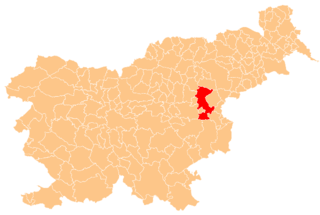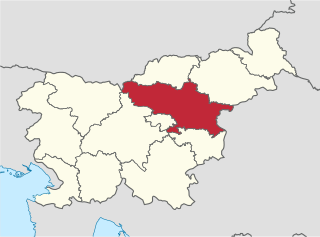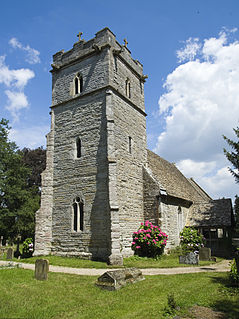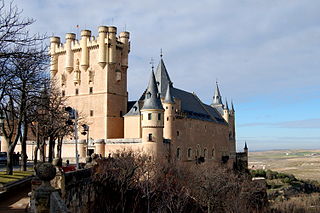
Prebold is a settlement in central Slovenia. It is the seat of the Municipality of Prebold. It lies on the edge of the lower Savinja Valley at the northern edge of the Sava Hills west of Celje. The area was part of the traditional region of Styria. The municipality is now included in the Savinja Statistical Region.

Šentjur is a town in eastern Slovenia. It is the seat of the Municipality of Šentjur. The town lies on the Voglajna River east of Celje. The area was part of the traditional region of Styria. The municipality is now included in the Savinja Statistical Region.

Brestanica is an urban settlement in the Municipality of Krško in eastern Slovenia. It lies in the valley at the confluence of the Sava River with a minor tributary called the Brestanica. The area was traditionally part of Styria. It is now included with the rest of the municipality in the Lower Sava Statistical Region.

Ivančna Gorica is a settlement and a municipality in central Slovenia. It is part of the traditional region of Lower Carniola and is now included in the Central Slovenia Statistical Region.

Teharje is a settlement in the City Municipality of Celje in eastern Slovenia. It lies on the right bank of the Voglajna River on the eastern outskirts of Celje. The area was traditionally part of the Styria region. It is now included with the rest of the municipality in the Savinja Statistical Region.

Setnica is a settlement that is divided between the municipalities of Dobrova–Polhov Gradec and Medvode in the Upper Carniola region of Slovenia. Setnica is known as Snica in the local dialect. In the 19th century it was known as Setnitza in German. The settlement includes the hamlets of Ravnek to the south, Mežnar below Saint Ursula's Church, and Kobilca in the Maček Gorge.

Pečine is a village in the mountains above the right bank of the Idrijca River in the municipality of Tolmin in the Littoral region of Slovenia. It includes the hamlets of Črni Vrh, Kabiunk, Kal, Maraževec, Podkal, Travnik, and Stari Rut.

Bizeljsko is a settlement in the Municipality of Brežice in eastern Slovenia, close to the border with Croatia. It lies on the right bank of the Sotla River and in terms of its territory is the largest settlement in the Municipality of Brežice. The area was traditionally part of Styria. It is now included in the Lower Sava Statistical Region. It includes the hamlets of Bošt, Nimnik, Gradišče, Župjek, Spodnja Sušica, Zgornja Sušica, Janežičeva Gorca, Vrhovnica, and Vitna Vas.

Bukovje is a settlement in the hills north of Bizeljsko in the Municipality of Brežice in eastern Slovenia. The area was traditionally part of Styria. It is now included with the rest of the municipality in the Lower Sava Statistical Region. It includes the hamlets of Graben to the west, which partially lies in the valley of Sračjak Creek, and Žalce, just above the Sotla River.

Čatež ob Savi is a village on the right bank of the Sava River at its confluence with the Krka River in the Municipality of Brežice in eastern Slovenia. The area was traditionally part of Lower Carniola. It is now included with the rest of the municipality in the Lower Sava Statistical Region.

Raka is a village in the Municipality of Krško in eastern Slovenia. The area was traditionally part of Lower Carniola. It is now included with the rest of the municipality in the Lower Sava Statistical Region. The village is known for a quality variety of onion.

Janče is a dispersed settlement in the hills south of the Sava River east of the capital Ljubljana in central Slovenia. It belongs to the City Municipality of Ljubljana. It was part of the traditional region of Lower Carniola and is now included with the rest of the municipality in the Central Slovenia Statistical Region.

Vodice pri Gabrovki is a settlement north of Gabrovka in the Municipality of Litija in central Slovenia. Traditionally the area was part of Lower Carniola and is now included with the rest of the municipality in the Central Sava Statistical Region. The settlement includes the hamlets of Zgornje Vodice, Spodnje Vodice, and Greben.

Drtija is a settlement in the Municipality of Moravče in central Slovenia. The area is part of the traditional region of Upper Carniola. It is now included with the rest of the municipality in the Central Slovenia Statistical Region. The settlement includes the hamlets of Belnik, Brinje, Gorica, Kovačija, Podbrdo, Kuga, Štance Laze, Štebalija, Štorovje, and Straža. Before the First World War, the hamlets scattered along the Slivna Plateau were collectively known as Za Goro.

Kolovrat is a settlement in the Municipality of Zagorje ob Savi in central Slovenia. The area is part of the traditional region of Upper Carniola. It is now included with the rest of the municipality in the Central Sava Statistical Region. The settlement includes the hamlets of Kal, Plavišnik, Prevalje, Spodnje Vrtače, Senčna Vas, and Strma Njiva.

Rodež is a village in the Municipality of Zagorje ob Savi in central Slovenia. The area is part of the traditional region of Lower Carniola. It is now included with the rest of the municipality in the Central Sava Statistical Region. The village includes the hamlets of Klenovik and Boriče.

Liboje is a settlement in the Municipality of Žalec in east-central Slovenia. It lies in the hills south of Žalec and southwest of Celje. The area is part of the traditional region of Styria. The municipality is now included in the Savinja Statistical Region. It includes the hamlets of Kurja Vas, Straža, and Svetli Dol or Tihi Gaj.

Močle is a village in the Municipality of Šmarje pri Jelšah in eastern Slovenia. It lies in the hills west of Šmarje. The area is part of the historical Styria region. The municipality is now included in the Savinja Statistical Region. It is a clustered village on the south side of a gentle slope. It includes the hamlets of Erpoge and Sveti Lovrenc.

Zlateče pri Šentjurju is a settlement in the Municipality of Šentjur in eastern Slovenia. The area is part of the historical region of Styria and is included in the Savinja Statistical Region.

Primož pri Šentjurju is a settlement in the Municipality of Šentjur in eastern Slovenia. The area is part of the historical Styria region. The municipality is now included in the Savinja Statistical Region. The settlement includes the hamlets of Bozne, Brezne, Grabne, and Kote.






















